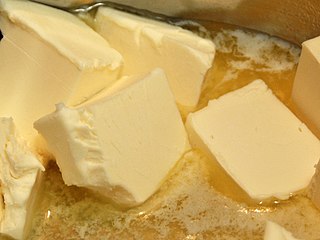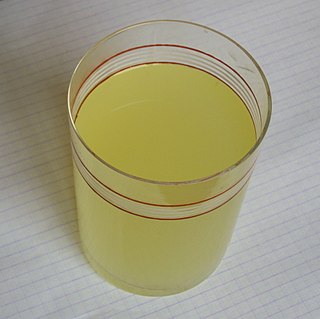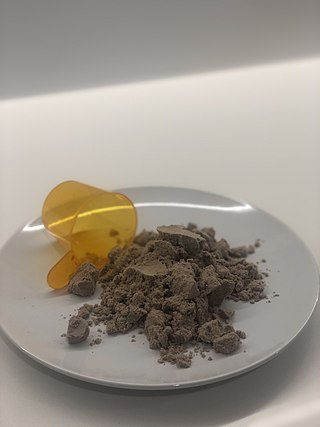Techniques

In the sugar industry the dry matter content is an important parameter to control the crystallization process and is often measured on-line by means of microwave density meters. [9]
The dry matter or dry weight is a measure of the mass of a completely dried substance.
The dry matter of plant and animal material consists of all its constituents excluding water. The dry matter of food includes carbohydrates, fats, proteins, vitamins, minerals, and antioxidants (e.g., thiocyanate, anthocyanin, and quercetin). Carbohydrates, fats, and proteins, which provide the energy in foods (measured in kilocalories or kilojoules), make up ninety percent of the dry weight of a diet. [1]
Water content in foods varies widely. A large number of foods are more than half water by weight, including boiled oatmeal (84.5%), cooked macaroni (78.4%), boiled eggs (73.2%), boiled rice (72.5%), white meat chicken (70.3%) and sirloin steak (61.9%). [2] Fruits and vegetables are 70 to 95% water. Most meats are on average about 70% water. Breads are approximately 36% water. [3] Some foods have a water content of less than 5%, e.g., peanut butter, [3] crackers, and chocolate cake. [4] Water content of dairy products is quite variable. Butter is 15% water. Cow's milk ranges between 88 and 86% water. Swiss cheese is 37% percent water. [3] The water content of milk and dairy products varies with the percentage of butterfat so that whole milk has the lowest percentage of water and skimmed milk has the highest.
The nutrient or mineral content of foods, animal feeds or plant tissues are often expressed on a dry matter basis, i.e. as a proportion of the total dry matter in the material. For example, a 138-gram apple contains 84% water (116 g water and 22 g dry matter per apple). [5] The potassium content is 0.72% on a dry matter basis, i.e. 0.72% of the dry matter is potassium. The apple, therefore, contains 158 mg potassium (0.72/100 X 22 g). Dried apple contains the same concentration of potassium on a dry matter basis (0.72%), but is only 32% water (68% dry matter). So 138 g of dried apple contains 93.8 g dry matter and 675 mg potassium (0.72/100 x 93.8 g).
When formulating a diet or mixed animal feed, nutrient or mineral concentrations are generally given on a dry matter basis; it is therefore important to consider the moisture content of each constituent when calculating total quantities of the different nutrients supplied. [6]
Cheese contains both dry matter and water. The dry matter in cheese contains proteins, butterfat, minerals, and lactose (milk sugar),[ citation needed ] although little lactose survives fermentation when the cheese is made.[ citation needed ] A cheese's fat content is expressed as the percentage of fat in the cheese's dry matter (abbreviated FDM or FiDM), which excludes the cheese's water content. [7] For example, if a cheese is 50% water (and, therefore, 50% dry matter) and has 25% fat, its fat content would be 50% fat in dry matter. [8]

In the sugar industry the dry matter content is an important parameter to control the crystallization process and is often measured on-line by means of microwave density meters. [9]
Dry matter can refer to the dry portion of animal feed. A substance in the feed, such as a nutrient or toxin, can be referred to on a dry matter basis (abbreviated DMB) to show its level in the feed (e.g., ppm). Considering nutrient levels in different feeds on a dry matter basis (rather than an as-is basis) makes a comparison easier because feeds contain different percentages of water. This also allows a comparison between the level of a given nutrient in dry matter and the level needed in an animal's diet. [10] Dry matter intake (DMI) refers to feed intake excluding its water content. The percentage of water is frequently determined by heating the feed on a paper plate in a microwave oven or using the Koster Tester to dry the feed. Ascertaining DMI can be useful for low-energy feeds with a high percentage of water in order to ensure adequate energy intake. Animals eating these kinds of feeds have been shown to consume less dry matter and food energy. [11] A problem called dry matter loss can result from heat generation, as caused by microbial respiration. It decreases the content of nonstructural carbohydrate, protein, and food energy. [12]

Food is any substance consumed by an organism for nutritional support. Food is usually of plant, animal, or fungal origin and contains essential nutrients such as carbohydrates, fats, proteins, vitamins, or minerals. The substance is ingested by an organism and assimilated by the organism's cells to provide energy, maintain life, or stimulate growth. Different species of animals have different feeding behaviours that satisfy the needs of their metabolisms and have evolved to fill a specific ecological niche within specific geographical contexts.

Nutrition is the biochemical and physiological process by which an organism uses food to support its life. It provides organisms with nutrients, which can be metabolized to create energy and chemical structures. Failure to obtain the required amount of nutrients causes malnutrition. Nutritional science is the study of nutrition, though it typically emphasizes human nutrition.

Butter is a dairy product made from the fat and protein components of churned cream. It is a semi-solid emulsion at room temperature, consisting of approximately 80% butterfat. It is used at room temperature as a spread, melted as a condiment, and used as a fat in baking, sauce-making, pan frying, and other cooking procedures.
A nutrient is a substance used by an organism to survive, grow and reproduce. The requirement for dietary nutrient intake applies to animals, plants, fungi and protists. Nutrients can be incorporated into cells for metabolic purposes or excreted by cells to create non-cellular structures such as hair, scales, feathers, or exoskeletons. Some nutrients can be metabolically converted into smaller molecules in the process of releasing energy such as for carbohydrates, lipids, proteins and fermentation products leading to end-products of water and carbon dioxide. All organisms require water. Essential nutrients for animals are the energy sources, some of the amino acids that are combined to create proteins, a subset of fatty acids, vitamins and certain minerals. Plants require more diverse minerals absorbed through roots, plus carbon dioxide and oxygen absorbed through leaves. Fungi live on dead or living organic matter and meet nutrient needs from their host.

A food pyramid is a representation of the optimal number of servings to be eaten each day from each of the basic food groups. The first pyramid was published in Sweden in 1974. The 1992 pyramid introduced by the United States Department of Agriculture (USDA) was called the "Food Guide Pyramid" or "Eating Right Pyramid". It was updated in 2005 to "MyPyramid", and then it was replaced by "MyPlate" in 2011.

Whey is the liquid remaining after milk has been curdled and strained. It is a byproduct of the manufacturing of cheese or casein and has several commercial uses. Sweet whey is a byproduct resulting from the manufacture of rennet types of hard cheese, like cheddar or Swiss cheese. Acid whey is a byproduct brought out during the making of acid types of dairy products, such as strained yogurt.

Buttermilk is a fermented dairy drink. Traditionally, it was the liquid left behind after churning butter out of cultured cream. As most modern butter in Western countries is not made with cultured cream but uncultured sweet cream, most modern buttermilk in Western countries is cultured separately. It is common in warm climates where unrefrigerated milk sours quickly.

Powdered milk, also called milk powder, dried milk, or dry milk, is a manufactured dairy product made by evaporating milk to dryness. One purpose of drying milk is to preserve it; milk powder has a far longer shelf life than liquid milk and does not need to be refrigerated, due to its low moisture content. Another purpose is to reduce its bulk for the economy of transportation. Powdered milk and dairy products include such items as dry whole milk, nonfat (skimmed) dry milk, dry buttermilk, dry whey products and dry dairy blends. Many exported dairy products conform to standards laid out in Codex Alimentarius.

Dairy cattle are cattle bred with the ability to produce large quantities of milk, from which dairy products are made. Dairy cattle generally are of the species Bos taurus.

Cat food is food specifically formulated and designed for consumption by cats. As obligate carnivores, cats have specific requirements for their dietary nutrients, namely nutrients found only in meat or synthesized, such as taurine and Vitamin A. Certain nutrients, including many vitamins and amino acids, are degraded by the temperatures, pressures and chemical treatments used during manufacture, and hence must be added after manufacture to avoid nutritional deficiency. Cat food is typically sold as dry kibble, or as wet food in cans and pouches.
Butterfat or milkfat is the fatty portion of milk. Milk and cream are often sold according to the amount of butterfat they contain.

A milk substitute is any substance that resembles milk and can be used in the same ways as milk. Such substances may be variously known as non-dairy beverage, nut milk, grain milk, legume milk, mock milk and alternative milk.
In animal husbandry, feed conversion ratio (FCR) or feed conversion rate is a ratio or rate measuring of the efficiency with which the bodies of livestock convert animal feed into the desired output. For dairy cows, for example, the output is milk, whereas in animals raised for meat the output is the flesh, that is, the body mass gained by the animal, represented either in the final mass of the animal or the mass of the dressed output. FCR is the mass of the input divided by the output. In some sectors, feed efficiency, which is the output divided by the input, is used. These concepts are also closely related to efficiency of conversion of ingested foods (ECI).
Food chemistry is the study of chemical processes and interactions of all biological and non-biological components of foods. The biological substances include such items as meat, poultry, lettuce, beer, milk as examples. It is similar to biochemistry in its main components such as carbohydrates, lipids, and protein, but it also includes areas such as water, vitamins, minerals, enzymes, food additives, flavors, and colors. This discipline also encompasses how products change under certain food processing techniques and ways either to enhance or to prevent them from happening. An example of enhancing a process would be to encourage fermentation of dairy products with microorganisms that convert lactose to lactic acid; an example of preventing a process would be stopping the browning on the surface of freshly cut apples using lemon juice or other acidulated water.

Soybean meal is used in food and animal feeds, principally as a protein supplement, but also as a source of metabolizable energy. Typically 1 bushel of soybeans yields 48 lbs. (21.8 kg) of soybean meal. Soybean meal is produced as a co-product of soybean oil extraction. Some, but not all, soybean meal contains ground soybean hulls. Soybean meal is heat-treated during production, to denature the trypsin inhibitors of soybeans, which would otherwise interfere with protein digestion.

The fat content of milk is the proportion of milk, by weight, made up by butterfat. The fat content, particularly of cow's milk, is modified to make a variety of products. The fat content of milk is usually stated on the container, and the color of the label or milk bottle top varied to enable quick recognition.

Pea protein is a food product and protein supplement derived and extracted from yellow and green split peas, Pisum sativum. It can be used as a dietary supplement to increase an individual's protein or other nutrient intake, or as a substitute for other food products. As a powder, it is used as an ingredient in food manufacturing, such as a thickener, foaming agent, or an emulsifier.

A staple food, food staple, or simply staple, is a food that is eaten often and in such quantities that it constitutes a dominant portion of a standard diet for an individual or a population group, supplying a large fraction of energy needs and generally forming a significant proportion of the intake of other nutrients as well. For humans, a staple food of a specific society may be eaten as often as every day or every meal, and most people live on a diet based on just a small variety of food staples. Specific staples vary from place to place, but typically are inexpensive or readily available foods that supply one or more of the macronutrients and micronutrients needed for survival and health: carbohydrates, proteins, fats, minerals, and vitamins. Typical examples include grains, seeds, nuts and root vegetables. Among them, cereals, legumes and tubers account for about 90% of the world's food calorie intake.

Feed manufacturing refers to the process of producing animal feed from raw agricultural products. Fodder produced by manufacturing is formulated to meet specific animal nutrition requirements for different species of animals at different life stages. According to the American Feed Industry Association (AFIA), there are four basic steps:
High performance sport dogs are those bred and trained to compete in various athletic events. Events include but are not limited to, agility trials, hunting and racing. These events are physically and metabolically demanding. As a result, canine athletes require specialized nutrition in order to perform at high levels during events and for maintenance and recovery. The main nutritional concern for sport dogs is adequate energy. A well-balanced diet, containing the appropriate amounts of protein, fat, carbohydrate, fiber and micronutrients is essential to meet these energy requirements.